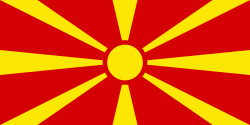Konče Municipality (Opština Konče)
Located below the slopes of Mount Serta, Konče is approximately 150 km away from the Skopje, North Macedonia's capital, on the Radovis-Strumica highway. The Municipality of Konce has a total area of 233.05 sq. Km and, as of the 2002 census, had a total population of 3,690 inhabitants. The ethnic composition of the Municipality of Konče's population consists primarily of Macedonians, but there is a significant Turkish minority. The current mayor of the Municipality of Konče is Blagoj Iliev.
There have been settlements in the region that constitutes the Konče municipality for more than four thousand years. Archaeological research done through the Museum of Štip conducted in the village of Gabrevci uncovered an early prehistoric community from the Bronze Age. Artifacts including ceramics and bronze implements are on display at the Museum in an exhibition room dedicated to the Gabrevci excavation. Konče has its contemporary origins as a Medieval-era religious and administrative seat. The oldest church in the municipality is located in the village of Konče and is dedicated to St. Stephen, dating to the fourteenth century. The church and associated monastery were built by Nikola Stajnevik, a Duke of Tsar Dušan and King Uroš in 1366. This complex, especially the church in its artistic value, occupies an important place in the history of Macedonian medieval culture. There are still original frescoes on the churches walls. Katarina Branković (1418/19–1492), the Countess of Celje and daughter of Despot Đurađ Branković and Byzantine princess Irene Kantakouzene, is buried in Konče. She is remembered for the Varaždin Apostol (1454), and her endowment of the Rmanj Monastery.
Map - Konče Municipality (Opština Konče)
Map
Country - Republic_of_Macedonia
 |
 |
The region's history begins with the kingdom of Paeonia, a mixed Thraco-Illyrian polity. In the late sixth century BC, the area was subjugated by the Persian Achaemenid Empire, then incorporated into the Kingdom of Macedonia in the fourth century BC. The Roman Republic conquered the region in the second century BC and made it part of the larger province of Macedonia. The area remained part of the Byzantine Empire, but was often raided and settled by Slavic tribes beginning in the sixth century of the Christian era. Following centuries of contention between the Bulgarian, Byzantine, and Serbian Empires, it was part of the Ottoman Empire from the mid-14th until the early 20th century, when, following the Balkan Wars of 1912 and 1913, the modern territory of North Macedonia came under Serbian rule.
Currency / Language
| ISO | Currency | Symbol | Significant figures |
|---|---|---|---|
| MKD | Macedonian denar | ден | 2 |
| ISO | Language |
|---|---|
| SQ | Albanian language |
| MK | Macedonian language |
| SR | Serbian language |
| TR | Turkish language |















